How to Increase FTP and Train Endurance
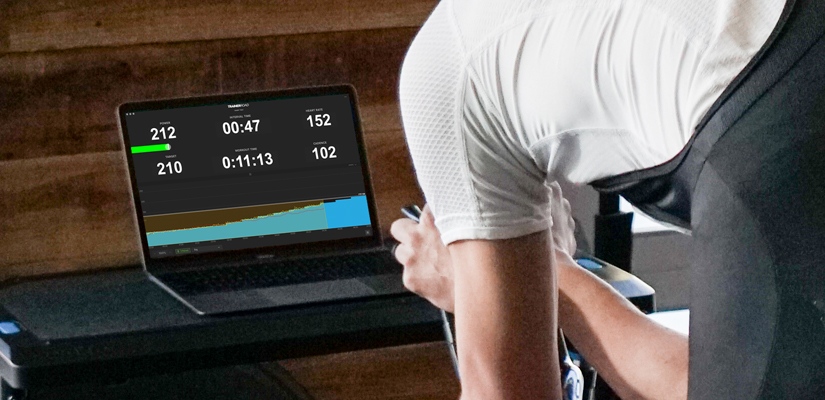
Functional Threshold Power (FTP) is a crucial cycling metric. Increasing your FTP improves your ability to hold higher power for longer—making you a faster cyclist. In this guide, we’ll cover the best ways on how to increase FTP.
For more information on how to increase FTP, check out Ask a Cycling Coach Ep 258.
What is FTP?
FTP is short for Functional Threshold Power and is an estimated measure of your highest sustainable power that you can hold for one hour. Essentially, it’s the balance between your aerobic and anaerobic energy systems where you are creating and processing lactate at nearly the same rate. This steady-state is often called lactate threshold and is nearly synonymous with FTP.
FTP is an important fitness metric as it indicates the amount of work you can sustain for long durations without overwhelming your aerobic system. This means that the more you increase FTP, the more work you can do aerobically—allowing you to go faster and farther.
How to Increase FTP?
The best way to increase your FTP is by strengthening your aerobic energy system. Since FTP is a measurement of your aerobic fitness, training that improves your aerobic capacity and muscular endurance will likewise increase FTP. Essentially, to raise your FTP, you need to grow your aerobic base fitness, then build upon it with more specific training.
Adaptive Training
Get the right workout, every time with training that adapts to you.
Check Out TrainerRoadAerobic base fitness is achieved through specific training and is the foundation upon which all further training is built. Throughout the Base Phase, you will increase the number of capillaries, increase the strength of your mitochondria, strengthen your heart, improve fat metabolism, and increase muscular endurance. The more base fitness you have, the higher you can build your FTP.
Once you’ve grown your aerobic base, it’s time to build upon it with more specific training. The Build Phase of training uses workouts, like threshold and VO2 Max, to raise your FTP. After the Build Phase, the Speciality Phase strengths your ability to express your FTP for what you need on race day.
Training Plans to Increase FTP
All TrainerRoad training plans work to increase FTP. But aside from other race considerations, the Time Trial plan is primarily focused on improving your FTP. You’ll start with Sweet Spot Base, then complete Sustained Power Build and finish more threshold work with the Time Trial Speciality Phase.
Increasing FTP and Training Power Zones
At one point or another, you’ve probably wondered what’s better – improving your FTP or increasing the amount of time you can spend riding at FTP. During a structured training plan, your ability to ride at threshold will increase, but realistically you won’t be able to ride at your threshold forever. In conjunction with improving endurance, your FTP needs to increase too, so that you can continue to challenge and grow your power zones.
There are seven different power zones. Active recovery, Endurance, Tempo, Sweet Spot, Threshold, VO2 Max, and Anaerobic Capacity. Each power zone is defined by a percentage of your Functional Threshold Power (FTP). The time you can spend in each zone is progressively limited. For example, athletes can generally stay in their endurance zone for multiple hours but can only stay above anaerobic capacity for a handful of seconds. The higher the power zone, the harder it should be to maintain time in that power zone. When your FTP raises, your zones change. A power output that you could only hold for a minute might be something you can hold for two minutes. This progress is incremental, but it has benefits to endurance and power.
Essentially, increasing FTP is the tide that lifts all ships. When you increase FTP, the physiological cost lessens. For example, let’s suppose a cyclist has an FTP of 200w and is riding in the Sweet Spot zone at 90% of their FTP or 180w. If they improve their FTP by 50w, the power increased to 225w. More watts equals more speed. But the other great thing is that riding at 180w has become substantially easier. Now, with a higher FTP, 180w is solidly in the Endurance power zone.
Increasing Endurance
Your training plan focuses on endurance and expanding stamina in a number of ways. For example, the intervals in a training plan can steadily increase in duration and difficulty from one workout to the next. Increasing the time you can spend in a power zone is intended to increase your muscular endurance. For example, during the Base phase, athletes spend a good amount of time increasing their ability to ride in the Sweet Spot zone. By steadily increasing the time you spend in the Sweet Spot zone, your workouts are improving your strength and muscular endurance.
You Can’t Increase Duration Forever
With that said, you can’t increase your ability to spend time in a power zone forever. You can only elevate the amount of time spent at a percentage of threshold for so long before it affects your threshold. Essentially, there comes a point where being able to hold a power value for a certain amount of time is an indication that your FTP and your zones are higher. Over time, the power that was your threshold can eventually become more like your Sweet Spot. This is why, in addition to workouts increasing your stamina and ability to spend time in a zone, they also focus on raising FTP. After establishing muscular endurance in the Base phase, the Build phase focuses on increasing your FTP.
If you can spend an extended amount of time in zones like threshold, VO2 max, and anaerobic capacity, this is an indication that it’s time to reassess your FTP. Your fitness has improved, and you’ll need an updated FTP if you want to continue to grow and challenge those higher power zones.
Workouts to Increase FTP
While a structured training plan is the best way to increase FTP, you might not be ready to start one just yet. Don’t worry! Use TrainNow to get the benefits of structured training, how and when you want, with intelligently recommended workouts. Here are some of our favorite workouts to increase FTP. These are effective and time-efficient, turning a minimal investment of time into significant results.
VO2 Max On-Offs
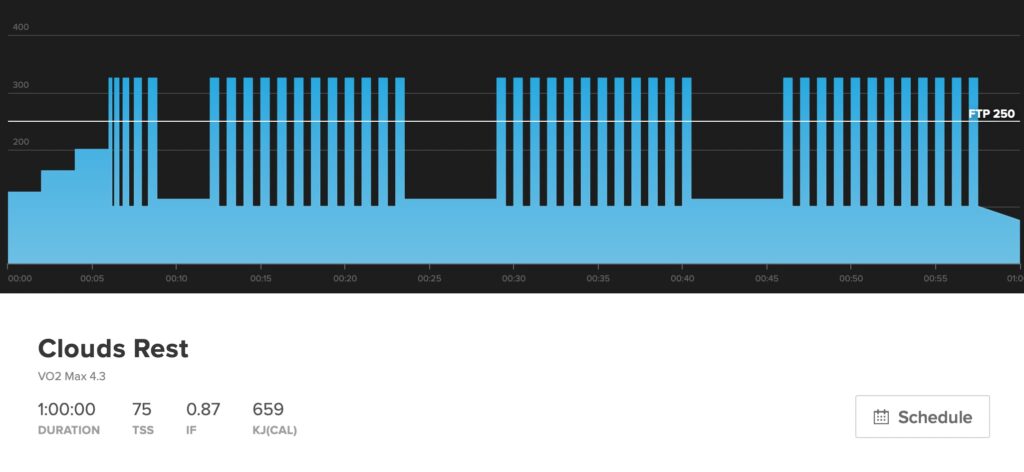
By working at very high percentages of your power at peak aerobic uptake (pVO2max), you can achieve tremendous improvements in both aerobic and anaerobic power, all in very little time. Short-duration, high-intensity repeats can be highly productive for all types of riders but are especially important for riders working on limited training time. Here, Clouds Rest features 30-second VO2 Max repeats that requires far less time than long, slow distance riding to increase FTP.
Sweet Spot
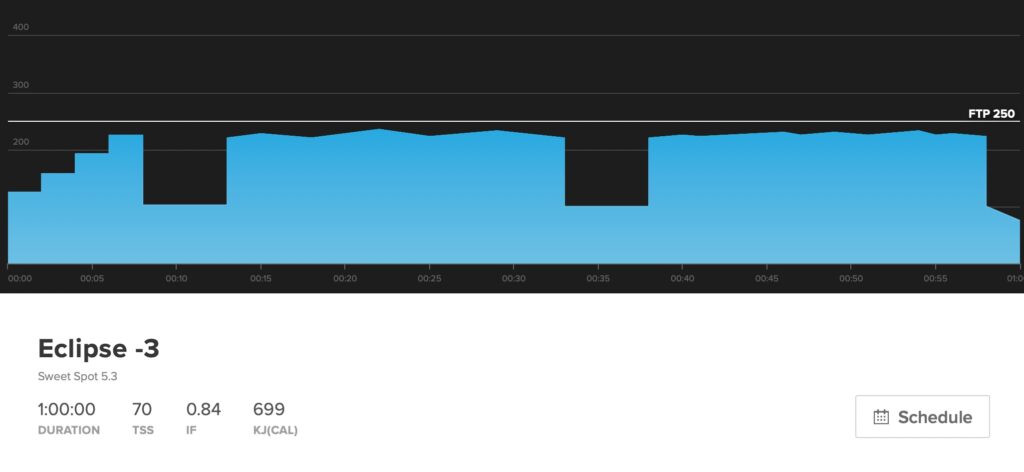
Sweet Spot intervals aim to further muscular endurance and enhance aerobic capabilities, leading to improved FTP. Additionally, you can improve glycogen storage in the muscles, better utilization of fat for fuel, a higher capacity for more intense workouts later on. Eclipse -3 is a classic example of a 2×20 Sweet Spot interval workout.
Over-Unders
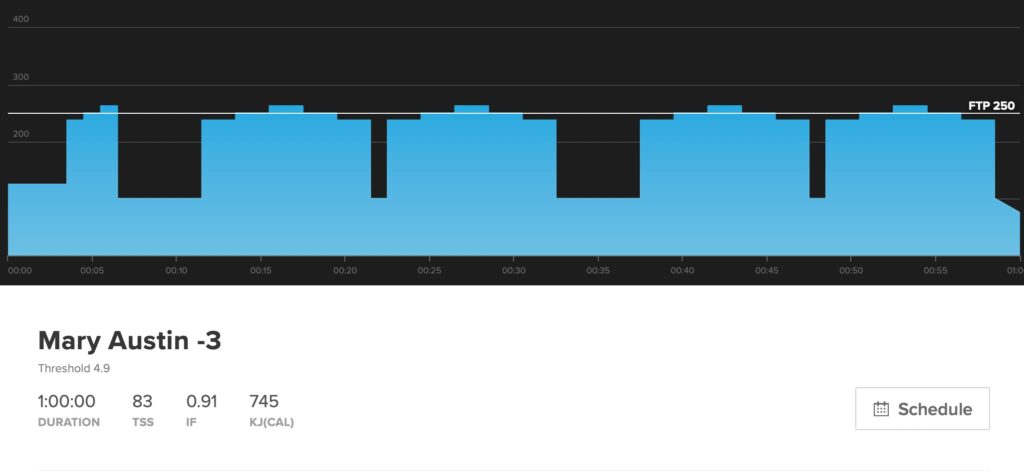
Over-Unders are a type of threshold-specific work that trains your body to deal with metabolic byproducts that come with riding above FTP. Mary Austin -3 is two sets of 2×10-minute intervals consisting of 2-minute steps up from 95% to 100% to 105% FTP and then back down again. Threshold workouts like this target both muscular endurance and lactate tolerance, which takes place at both the muscular level and a psychological one. Your muscles gradually adapt to increasing levels of lactate and acidic accumulation as they improve their ability to process these metabolic byproducts more effectively—leading to FTP improvements.
Sustain VO2 Max
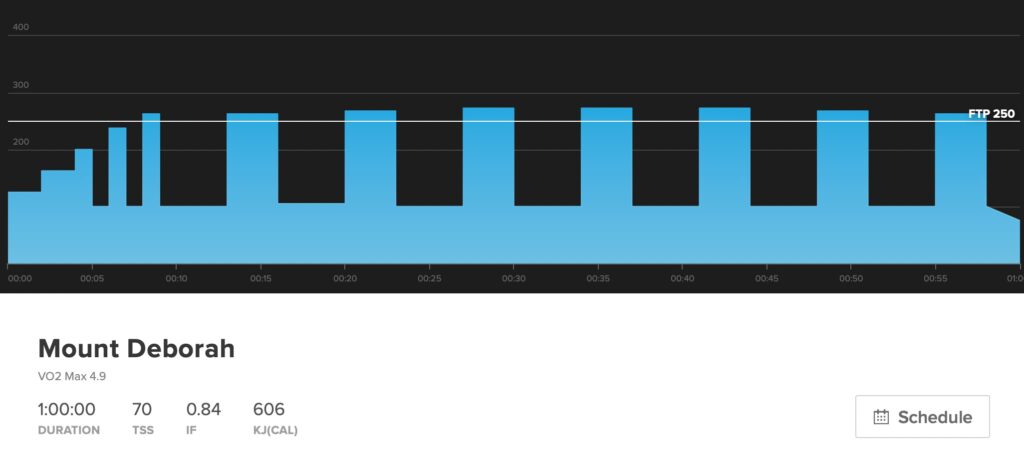
No two ways about it, long VO2 Max intervals are hard. Holding power above FTP is, by its nature, short-term since it’s a tough place to reside. But by working at mildly suprathreshold power outputs, you can increase FTP, while gaining some meaningful aerobic adaptation in the process.
Endurance
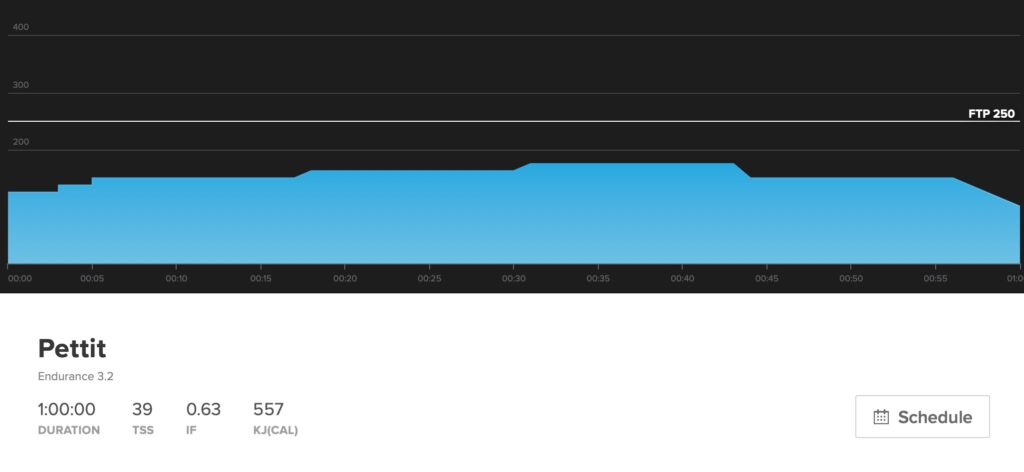
Aerobic Endurance workouts are aimed at improving your FTP in a low-stress manner. By riding for increasingly longer periods of time, your endurance muscle fibers become more efficient at utilizing fat for fuel and sparing sugar stores for more intense efforts. Additionally, Endurance workouts like this can improve oxygen delivery and utilization, and improve muscular resistance to fatigue. Endurance workouts like Pettit help fill the gap between high-intensity workouts by providing some low-stress stimulus.
When to Take a FTP Test
Luckily, it’s easy to keep your training on track and your zones in line when you assess your FTP regularly. You’ll be prompted to take a Ramp Test at the start of each new training block to keep this number up to date. With that said, after a hard block of training, it’s normal to feel tentative about training at a new FTP. You might even be tempted to skip your Ramp Test and continue training with the same power values. But you shouldn’t do this! If you skip a test, you might be shortchanging your next block of training. Your FTP needs to be updated for your workouts to target all of your power zones accurately. If you don’t update your FTP, you won’t be training your max efforts or accurately training the rest of your zones.
The good news is that if you reassess your FTP and it increases, this is an indication that you’ve gotten stronger and will need those harder workouts to make sure you are getting the most from your hard work. Keeping your FTP up to date keeps your training tailored to your fitness.
The goal of a structured training plan is to increase stamina and power progressively. The workout in your plan that looks impossible today will be possible one day. It will probably even be possible at a higher FTP! It’s all about taking your plan one workout at a time and trusting the process. Your stamina and your power will come incrementally with progressive structured workouts.
Tips on How to Increase FTP
- Stay consistent. This is a key to getting faster because it allows you to build and promote adaptation sustainably.
- Pick the right training volume that matches your schedule and lifestyle.
- Fuel your workouts to provide the body everything it needs for adaptation.
- Focus on recovery. Training is hard and getting enought recovery and sleep will help your hard work pay off.
- Assess your FTP every 4-6 weeks to ensure the workouts are scaled to your fitness level.
Your FTP is a Tool
Remember that your FTP is a tool used to keep your training accurate. As exciting as it is to see that FTP grow, it’s not always going to increase, and it doesn’t always need to increase. The Ramp Test is designed to assess your FTP accurately. If you just finished a block of training where you missed some workouts, took a vacation, or had a lot of real-life stress, you might see that number decline, which is okay! Sometimes training gets interrupted. The Ramp Test is placed at the beginning of your plan to keep your training on track, and ensure that you are training in the most efficient and effective way.
How TrainerRoad Increases Your FTP
TrainerRoad used science-based planning and training tools that are designed to increase your FTP. In every plan, you’ll progress through the Base, Build, and Speciality phase, ensuring you are getting the right workouts at the right time. But the best training plans won’t work unless they are built around you, your goals, and your life. Plan Builder will take the time you have, experience, and goal event to create the perfect plan—one that works for you.
For more cycling training knowledge, listen to Ask a Cycling Coach — the only podcast dedicated to making you a faster cyclist. New episodes are released weekly.
